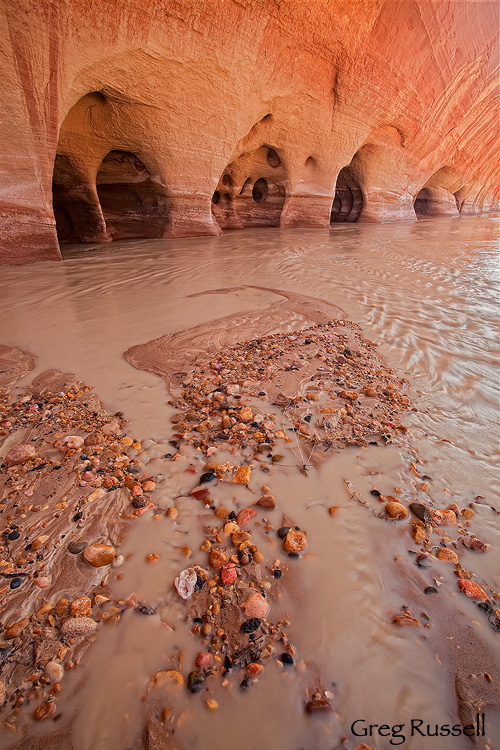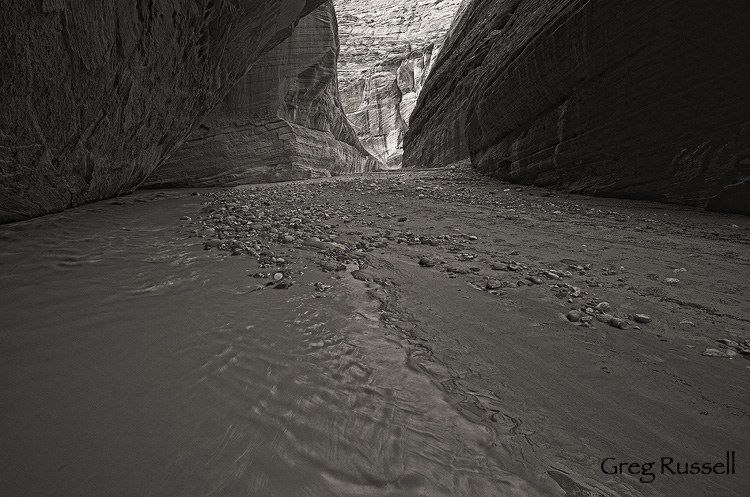In the spirit of David Hyde’s travelogues (read the most recent here), I’ll present my recent trip to southern Utah in three parts. However, rather than document the trip, I’ll write about three themes that came to mind as I hiked, and photographed.
Although I visited other locations (like Valley of Fire State Park), the primary purpose of my recent trip was to hike a portion of the Paria River, between the White House trailhead, and its confluence with Buckskin Gulch. I think the Paria was one of those rivers I was meant to spend time with at some point in my life. As a teenager, I remember reading about some of the “classic” rivers of the southwest: the Dirty Devil, the Escalante, and–of course–the Paria. Unlike most of my peers at the time, I found a certain draw in that lovely, beautiful, muddy water. The hike all the way to Lee’s Ferry, Arizona is considered to be one of the finest backpacking trips in the region.
Last week, I spent a day in the canyon, which starts out broadly, and narrows down after about 4 miles. One thing I immediately noticed about the Paria is that its gorgeous–beautiful–but that beauty isn’t as in-your-face as other locations in the Southwest, like Zion, or the Wave. This subtle beauty becomes apparent as you sit watching sandstone walls and erosions as the light passes, playing on it. Or, as you contemplate the effects of thousands of years of wind and water on the stone.
Once you enter the Paria narrows, the canyon turns from a broad, meandering line to a series of twists and turns. However, the overhanging sandstone walls to give occasional views of the “outside.” Again, subtle beauty is key.
Grand, subtle, nuances prevail in the Paria River canyon. What areas do you find these qualities in?



Wonderful images Greg of this very special place. The Paria (and Buckskin) don’t have the immediate “wow” factor of the Wave, but they do have their own magic for those willing to take the time.
Really nice, Greg, especially that first one. Catching that kind of subtle beauty is something I struggle with a lot in southern New Mexico. The canyons and mountains down there are gorgeous, but they don’t have ground above treeline, and they don’t have many large expanses of bare rock. So it’s a real challenge to find grand landscape views, and time is often better spent looking for those telling details which can convey the beauty on an intimate scale. Frankly, I’m not very good at it, but I keep trying and with any luck I’ll improve.
Gorgeous post Greg, some lovely words and a couple of great images that compliment them well. Nicely done amigo.
I find those subtle nuances everywhere, even in the most spectacular country imaginable.
I think that’s why it can take so long to really get to know an area. It takes time for the subtleties to emerge.
Thanks for the comments! The Paria really is a special place, with grand beauty (if you look for it) as well as lovely intimate landscapes. PJ, you’re right, it can take a while to get to know the area, but as touchy-feely as this sounds, some places have the ability to open your mind and heart in such a way that the creativity flows.
Jackson (or anyone), do you think that some landscapes, although pretty, just aren’t photogenic? I feel that way about some local places that I think are beautiful. This might make a good blog post, or discussion here…
Yes Greg, I would tend to agree about pretty but non-photogenic places. That’s absolutely not to say that one can’t make good images in such locations, but it takes a lot more work. Again, alpine, slickrock or coastal environments provide tremendous options for clean comps, and the photos often just seem to flow. On the other hand, thick woods are a great example of a biome that’s beautiful but really challenging. I have enormous respect for all those eastern photographers who can make good comps under the canopy in the Smokies and whatnot.
I’ve got a post in the hopper from Ojito Wilderness, a beautiful and fascinating area which has been a relatively tough nut to crack photographically. It’s full of fascinating rock formations, but also tends to be very busy with brush and debris. It’s taken me numerous trips there to finally hit a little paydirt.
Great post, Greg, and two beautiful shots. The second is most intriguing with wonderful lines, textures, light play – beautifully seen and executed.
Sharon
I hiked the rim above the canyon and found some really interesting formations. But I really wanted to go back and hike through the canyon because of what I saw from above. Haven’t made it back yet. Still on the list.
Good image from a tough place to get them.
For me it’s the White Mountains. I don’t think that I have really gotten what I want from an image yet. I usually just end up standing there and staring at the way the light in the evening just turns them into a magic place.
You’re completely right, Jackson. Shooting in the woods/forest is a special skill; while I’ve gotten lucky a few times, a lot of my images made in those situations haven’t really worked out.
Kah Kit Yoong had a blog post addressing what he thought the “levels” of difficulty are in landscape photography; you might find it interesting:
http://www.magichourunplugged.com/2010/12/21/seeing-the-trees-and-the-forest/
Greg, I feel the same way about the White Mountains. I spent 4 summers in the Whites during grad school, and while I still shot film at the time, I would love to get back up there to make some better images.
Thank you Sharon! That’s one of my personal favorites from the trip…I love the lines.
Thank you for the link. That first image is fantastic. I like the variety of colors besides the red rock wall and the repeating patterns.